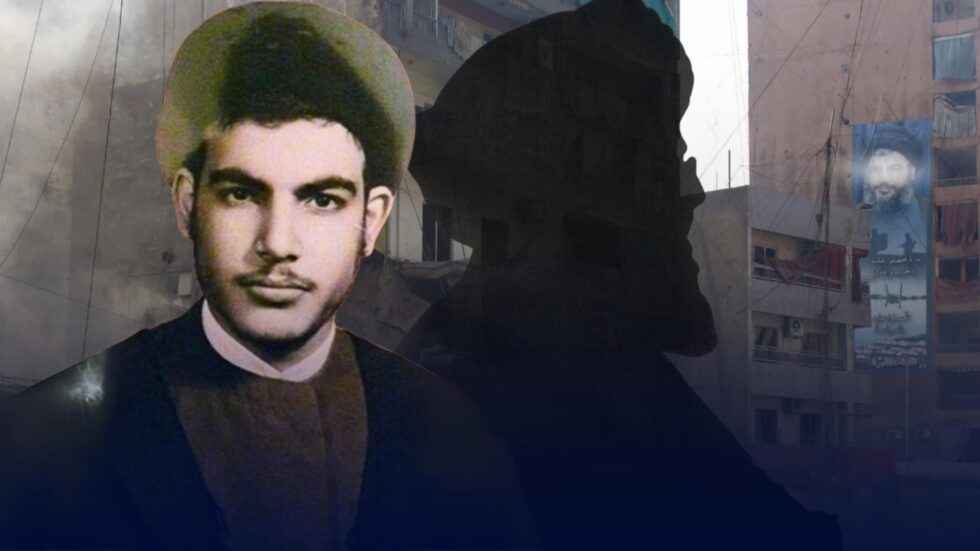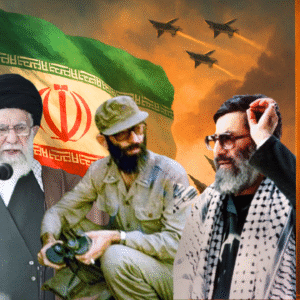One Year On: The Anniversary of the ‘Nation’s Martyr,’ Sayyed Hassan Nasrallah

“We will continue to walk this path. Even if we are all killed, even if we are all martyred, even if our homes are destroyed over our heads, we will not abandon the option of Islamic resistance.” — Sayyed Hassan Nasrallah
For decades, his voice coursed through Lebanon like a lifeline—carried on radios, television screens, and whispered from neighbor to neighbor in the pauses of daily life. Children grew up with it stamped into memory, wide-eyed as they pressed against crackling transistor sets, learning that courage was not the absence of fear, but the will to endure it. Adults clung to his words not as slogans, but as anchors: a fulcrum of hope in times when hope itself was all but extinguished, and a reminder that even under siege, even in the ruins of war, defiance still drew breath.
Even those who rejected his politics could not dismiss the weight of his presence: a voice that silenced rooms, unsettled opponents, steeled the weary, and carved meaning out of despair.
This was the figure who came to define an entire generation’s understanding of resilience, and whose death in September 2024 marked not only the loss of a prominent leader, but also the turning of a chapter in the modern history of Lebanon and the wider region—a chapter both concluded and renewed in the spirit he left behind.
In the streets of Lebanon, in the memory of the region, and in the literature of resistance, Sayyed Hassan Nasrallah remains less a man lost than a measure by which defiance itself is understood.
The Life That Forged the Voice
Sayyed Hassan was born in 1960 in the dense quarters of East Beirut, with roots that reached into the neglected villages of southern Lebanon. His father kept a modest grocery; his family, like many in the south, knew the quiet pressures of poverty and marginalization.
As a boy, he hauled crates through narrow alleys and listened to the talk of markets and doorways. That street cadence stayed with him, and years later, it would shape a register of speech that folded resolve into dignity and made abstractions feel lived.
In adolescence he turned to religious study, first in Lebanon, then in the seminaries of Najaf and Qom. There he absorbed a tradition that refused to separate faith from justice. Jurisprudence and theology were not only disciplines; they were instruments of conscience, training the will to stand upright when the world pressed down. Under the influence of figures such as Imam Musa al-Sadr and the scholars around Imam Khomeini, he learned to treat endurance as a principle, not a posture.
The Israeli invasion of 1982 bent the arc of his life. He left the Amal Movement and entered the small, disciplined nucleus that would later become Hezbollah, a formation born in the furnace of occupation, displacement, and competing ideologies.
A decade later, after the assassination of Sayyed Abbas al-Musawi, Nasrallah became Secretary-General at thirty-two. The appointment seemed improbable only in age, as in consequence, it proved decisive. His leadership married organization to message, the training ground to the pulpit, and the litany of belief to the calculus of war.
Under his stewardship, Hezbollah became more than an armed apparatus. It put clinics where there had been none, repaired schools and roads after bombardments, and formed social service networks that reached households the state had abandoned.
To supporters, this duality conferred legitimacy: resistance on the frontier and refuge in the neighborhood. To critics, it blurred the line between politics and arms. Either way, it altered the daily grammar of survival and made Hezbollah a fact of ordinary life.
Two moments fixed his place in modern Arab memory. In May 2000, Israeli forces withdrew from southern Lebanon; it was the first compelled retreat of its kind without negotiation, and it rewrote the region’s sense of possibility.
In July 2006, during thirty-three days of war, his speeches, delivered from undisclosed locations, moved along the country’s electrical nerves: radio and television, generators humming, families gathered in rooms lit by the grain of old screens. The tone was steady, almost spare. It granted coherence when coherence was scarce and transformed endurance into a shared undertaking.
The years that followed were harder and even more complex. Hezbollah’s entry into the Syrian war against ISIS, Lebanon’s economic unraveling, and a tightening ring of confrontation with Israel and Western powers deepened internal divides. Yet even adversaries conceded that Nasrallah had few counterparts in stature or command. He occupied a rare space in public life: a cleric who spoke like a neighbor, a strategist who could be understood over dinner tables, a leader who turned doctrine into the habits of daily resilience.
When September Refused to End
September 2024 descended on Lebanon like a shadow cast long before its hour. Devices meant to carry messages—pagers and walkie-talkies—turned into instruments of sudden, indiscriminate destruction, detonating in hands, homes and marketplaces.
Hospitals overflowed with the wounded; streets and markets became fields of chaos; neighborhoods that once held the rhythm of daily life now lay fractured, silent, and scarred. Above, the relentless drone of bombers tore through the sky, a grim reminder that no sanctuary—home, street, or familiar corner—would escape the merciless reach of Zionism.
Through this onslaught, Sayyed Hassan Nasrallah— the most consequential Arab figure of modern resistance in the Middle East—was killed.
This was no ordinary reckoning in the region’s cycles of conflict. It was a systematic breach of law, morality, and human conscience, a coordinated assault on life, on community, and on the very trust that binds a society together. People blinded, hands severed, families uprooted: these are not mere numbers, but enduring testimony to relentless violence.
The Pager Explosions
On the morning of 17 September 2024, Lebanon awoke to a horror unprecedented in modern warfare. Thousands of handheld pagers, carried by members of Hezbollah across Lebanon and Syria, suddenly detonated almost simultaneously. These were not simply devices in the hands of fighters; many belonged to men who served in civilian institutions under Hezbollah’s social infrastructure, providing services in hospitals, schools, and local municipalities.
The following day, as families were still reeling and hospitals struggled to cope, a second wave of explosions tore through hundreds of walkie-talkies distributed among the same networks. A tool of communication had been transformed into an instrument of indiscriminate carnage.
The toll was staggering. Over 3,500 people were wounded, with at least 42 killed in the twin assaults. The dead included not only combatants but also health workers, ambulance drivers, engineers, and administrative staff whose roles were far removed from the battlefield. The injuries were catastrophic.
Human rights organizations quickly underscored the gravity of the attacks. Amnesty International organizations documented how many of the devices were distributed among Hezbollah’s civilian institutions, including hospitals and social service centers, and called for an independent investigation into what they meekly described as a “likely” violation of international humanitarian law.
Amnesty’s report detailed how several victims were killed or injured at their workplace desks or in their homes when the pagers detonated. Others recalled the chilling seconds before the blast, when the pager gave a familiar “beep,” prompting its owner to raise it closer to the face, only for it to explode in their hands. The cruel design of the attack was not only to kill but to exploit trust in the mundane, transforming routine into horror.
Meanwhile, legal experts have characterized the operation as a textbook case of indiscriminate warfare. The laws of armed conflict rest on three central principles: distinction, proportionality, and precaution. In this case, all three were manifestly violated. Civilian staff were targeted alongside fighters, rendering distinction meaningless; the injuries numbered in the thousands for limited military gain, flouting proportionality; and precaution was abandoned entirely, as the very act of weaponizing ubiquitous communication devices created uncontrollable blast zones in homes, workplaces, and streets.
As the United Nations High Commissioner for Human Rights, Volker Turk, noted, simultaneous targeting of thousands of individuals “without knowledge as to who was in possession of the targeted devices, their location and their surroundings at the time of the attack, violates international human rights law and, to the extent applicable, international humanitarian law.”
Human Rights Watch reinforced this view, highlighting that such devices, whose precise locations could not be reliably known, are inherently indiscriminate, striking civilians and combatants alike without distinction. The attacks, in both design and effect, exemplified a chilling disregard for the laws meant to contain the horrors of war.
Beyond the immediate devastation, the psychological shock was profound. In a society where communication devices were lifelines during years of conflict, the pager explosions corrupted trust in the tools of everyday survival. Parents hesitated before answering their phones, aid workers recoiled at the sight of radios, and hospitals already overrun by casualties now had to confront the trauma of staff wounded by the very devices meant to coordinate relief.
The explosions thus tore through more than flesh and bone; they struck at the cultural fabric of resilience, at the unspoken trust that technology could connect rather than betray. As one survivor in Beirut, Zainab Mestrah, told BT: “I never imagined that our enemy could be so utterly devoid of morals. They never considered that those pagers might fall into the hands of children, women or non-combatant civilians.”
The pager attacks, therefore, were not merely tactical blows in a confrontation between Israel and Hezbollah. They represented a deliberate assault on the concept of safety itself. By weaponizing tools of daily communication, Israel extended the battlefield into kitchens, clinics, and classrooms. The result was not only mass injury but the seeding of collective fear, the kind of psychological wound that endures long after rubble is cleared and bodies are buried.
Death in Dahieh
The pager attacks were not the end, but the prelude. In the days that followed, Israel intensified its assault on Lebanon with a ferocity unseen in decades. Entire districts came under bombardment, particularly in Beirut’s southern suburbs, the Bekaa Valley, and southern villages long scarred by conflict.
The strikes were justified in Israeli statements as blows against “Hezbollah’s military infrastructure,” yet the craters told a different story. Apartment blocks were reduced to heaps of twisted steel and concrete, market streets lay shattered, and civilians fled under the roar of warplanes that circled above their homes without respite. Between 23 and 26 September, the casualties mounted relentlessly, the injured counted in the hundreds, the displaced in the tens of thousands. Neighborhoods were ordered to evacuate en masse, transforming bustling quarters into ghost towns overnight.
It was in this climate of dread and displacement that the most consequential strike of all took place. In that onslaught, Sayyed Hassan Nasrallah—Secretary-General of Hezbollah, and the figure who for more than three decades had defined both the face and the philosophy of modern Arab resistance—was killed.
On September 27, 2024, as Israeli Prime Minister Benjamin Netanyahu stood at the United Nations in New York promising to keep “degrading Hezbollah,” Israeli jets unleashed their most decisive strike on Beirut’s southern suburb of Dahieh. Within minutes, six apartment towers crumbled into dust and flame, burying families, aides, guards, and leaders alike.
Among them was Sayyed Hassan Nasrallah. The attack was no improvisation: Israeli officials later acknowledged it had been authorized days earlier and timed to coincide with Netanyahu’s speech. U.S. officials insisted they had received no advance warning, yet analyses of the rubble revealed the use of massive ordnance—some American-made—that left a devastation so complete, that it could only have been the product of deliberate design.
The ceasefire that would eventually silence the front was still two months away. In the meantime, the strike became more than a military operation; it was a message staged for the world, calibrated to erase a man and remind a people of their fragility. What ended that night was a body and a voice. What endured, however, was the weight of absence itself—an absence that redefined the measure of resistance for Lebanon, and for all who still live beneath the shadow of power unrestrained.
Alongside Nasrallah fell dozens of senior leaders, security personnel, and ordinary civilians who had the misfortune of living above the targeted site. Official tallies spoke of at least dozens of injuries, but regional media and eyewitness accounts painted a grimmer picture, with casualties numbering far higher, and bodies still being pulled from debris days after the dust had settled.
The significance of this moment cannot be overstated. To his supporters, Nasrallah was not merely the Secretary-General of Hezbollah; he was a voice of defiance that had altered the balance of power in the region since the 1990s. His leadership had withstood wars, assassinations, and relentless pressure, and his words had traveled across borders to inspire millions who saw in him a man unbent by the weight of empire. His killing was not just a military act—for those who rallied behind him, it was an attempt to decapitate a movement.
Yet even in death, the circumstances of the strike raised profound legal and moral questions. By striking a target buried beneath civilian housing, Israel knowingly endangered non-combatants, violating the core principle of distinction under international humanitarian law.
The destruction of six residential buildings for the elimination of a single leader, however significant militarily, stands as a glaring breach of the principle of proportionality, which demands that civilian harm must never outweigh anticipated military advantage. As the Lebanese newspaper Al-Akhbar wrote in the aftermath: “This was not a strike against a man, it was the leveling of a community’s heart, and with it, the laws of war themselves.”
For Lebanon, the 27th of September will not be remembered as a date on a military calendar. It will be remembered as the night when an airstrike carved a wound into the conscience of a nation. Loved ones were lost, communities were fractured, and the entire region lost a longstanding symbol of defiance, yet amid the grief and rage, one truth resounded: the strike may have silenced a voice that defined an era, but not the chorus of resistance that his words inspired.
Legal, Moral, and Strategic Dimensions
The attacks of September 2024 did not merely injure and displace—they opened profound legal and ethical questions. The weaponization of everyday devices such as pagers and walkie-talkies blurred the essential principle of distinction between combatants and civilians.
International humanitarian law requires that weapons and tactics discriminate between the two. In this case, no such distinction was possible. When a device in a medic’s hand, a teacher’s pocket, or a worker’s home detonates, the line that should separate battlefield from civilian life collapses.
The doctrine of proportionality also stands in question. Israel’s stated objectives were to degrade Hezbollah’s capabilities, but the scale of civilian injury and death was immense. Evacuation warnings do not absolve an aggressor of the duty to minimize harm. Ordering families to leave their homes, only to strike those very dwellings, cannot be framed as lawful precaution. What remains is responsibility: for the destruction, the trauma, and the irreversible civilian loss.
The choice of method points towards a strategy that extended beyond military effect. These attacks were not only about eliminating personnel or infrastructure but about dismantling trust itself. When communication devices, lifelines in both war and peace, turn into instruments of death, they corrode more than bodies. They corrode confidence in the ordinary, embedding fear in the fabric of daily life.
Hospitals, schools, and communities were left shaken not only by casualties, but by the profound betrayal of what had been ordinary tools of safety and coordination. As Sayyed Hassan Nasrallah himself described, the attacks crossed “all red lines,” representing a massacre with clear intent to inflict mass civilian suffering.
This raises a deeper introspection: the contest over truth, memory, and moral witness. Narratives will differ, as they always do in war, but the evidence is stark—amputated limbs, blinded eyes, demolished homes, grieving families. These facts cannot be buried under propaganda or spin. They remain as testimony that demand recognition.
And then there is the death of Nasrallah himself. His assassination by Israeli airstrikes is more than the silencing of a leader; it is the forced closure of a defining chapter in Middle Eastern resistance. To his followers, his martyrdom is not a defeat but a continuation—the endurance of what he represented, carried forward by those who remain. Even to his critics, his killing marks a seismic shift. Wars often hinge on symbolism as much as strategy, and in this case, the symbolism of martyrdom ensures that his absence will echo as loudly as his presence once did.
What Cannot Be Forgotten
Beyond the statistics and political statements lies the unyielding reality of human loss. The faces of children who will never see again, the hands that once held pens or tools now reduced to absence, the families whose homes were turned to rubble—these are not abstractions. Each medical record, each scar, each shattered wall is evidence, etched in permanence.
The destruction did not stop at individuals. Community infrastructures, hospitals that once healed, markets that once bustled with daily life, neighborhoods that once offered familiarity and belonging, were ripped apart. These were not just physical spaces; they were the connective tissue of society, and the places where trust, care, and routine gave meaning to existence. Their devastation rends the bonds of community as violently as any bomb tears through concrete.
And then there are the displaced—families driven from their homes, forced into transience, clutching at survival in shelters or along uncertain roads. Their lives have been suspended not only by the violence of explosions but by the violence of uprooting. By living in fear without ever knowing when the next strike will fall, they carry both the visible and invisible weight of war.
What cannot be forgotten is not just the destruction itself, but the dignity of those who endured it, and the responsibility of history to preserve their witness.
Viral Indifference and the Limits of Awareness
Yet even as Lebanon reeled from these attacks, a troubling reality emerged. Much of the world, and even segments of the Muslim Ummah, scarcely registered the scale of the tragedy. Some dismissed it as distant news; others mocked or trivialized the violence, turning suffering into memes. This is not mere apathy, but a reflection of deeper structural issues: sectarian divisions, media hierarchies, and the viral dynamics of attention that elevate spectacle over human life.
Only a few grasped how the pager attacks and the subsequent airstrikes were connected to the wider geopolitical struggle: the ongoing operations of Hamas, the enduring conflict in the West Bank, the destabilization of Syria, and Iran’s confrontation with the global Zionist agenda.
Losses and victories that should have commanded attention instead passed without proper scrutiny, their significance overshadowed despite the fleeting headlines they sparked. Even though the news of atrocity circulated and continues to resonate in personal and media narratives, its significance is often distorted or reduced to sentiment, obsession, spectacle, or propaganda. Such framing risks diluting understanding, eroding empathy, weakening collective memory, and undermining accountability.
In this sense, the selective attention of audiences is itself a battlefield. By ignoring or trivializing suffering, society permits the erasure of both civilian harm and the political significance of resistance. To remember, document, and speak of these events is to resist that erasure. Memory becomes a form of justice; witness becomes an act of moral defiance.
Toward Justice and Memory
Accountability starts with confronting the silences that surround these attacks, and the ways their impact has been muted or misrepresented. Lebanese civil society, joined by international human rights organizations and UN bodies, has called for thorough investigations into both the covert detonations and the subsequent airstrikes. Crucial questions demand answers: who gave the orders, who sanctioned the operations, and what awareness accompanied these decisions? To ignore them is to grant impunity, allowing violations of this scale to fade into deliberate neglect.
Yet accountability also depends on evidence, and here too lies a critical responsibility. Documentation cannot be reduced to statistics alone; it must encompass the medical records of amputated limbs, the testimonies of survivors, the photographs of leveled homes, and the forensic traces that speak when propaganda tries to silence them. Each preserved fragment of truth forms a bulwark against erasure, ensuring that the enormity of what occurred cannot be rewritten or denied.
To remember is itself an act of resistance. In a world where violence is often normalized, overlooked, or treated as entertainment, speaking the names of the victims, recounting their stories, and insisting on the illegality and immorality of what was done keeps the wound visible. Memory, carried forward with rigor and moral intent, becomes a form of justice: a refusal to allow atrocity, indifference, or inaction to pass quietly into history.
In these events, from the rupture of pagers in living rooms to the collapse of underground bunkers beneath apartment blocks, there is a story of intentional harm, yes, but also of unyielding endurance. The sons and daughters of Lebanon–wounded but unbowed; the witnesses; the doctors who stitched flesh, the families that wake each morning with loss; the communities that keep faith in memory.
If you value our journalism…
TMJ News is committed to remaining an independent, reader-funded news platform. A small donation from our valuable readers like you keeps us running so that we can keep our reporting open to all! We’ve launched a fundraising campaign to raise the $10,000 we need to meet our publishing costs this year, and it’d mean the world to us if you’d make a monthly or one-time donation to help. If you value what we publish and agree that our world needs alternative voices like ours in the media, please give what you can today.




